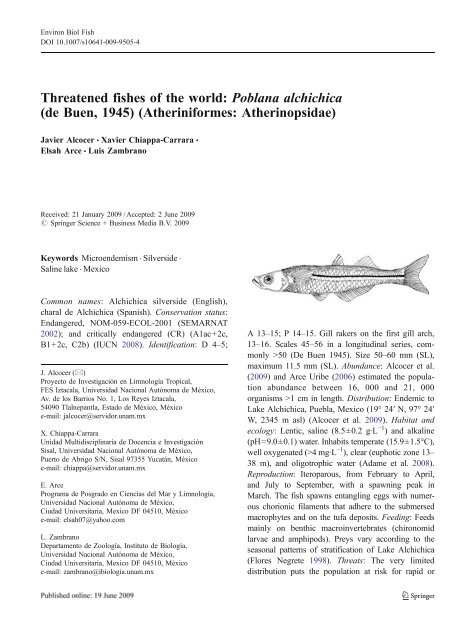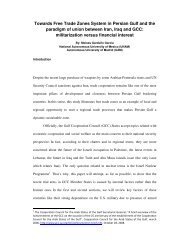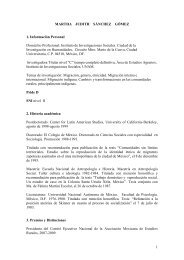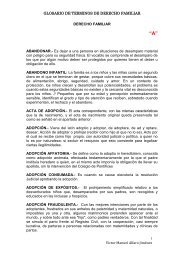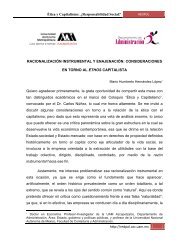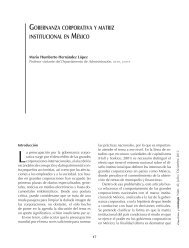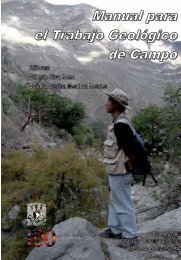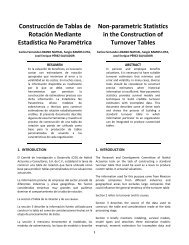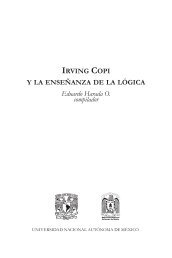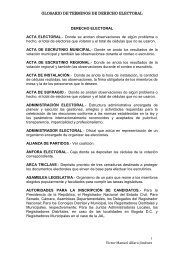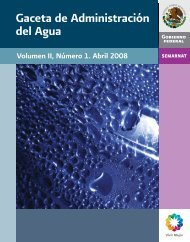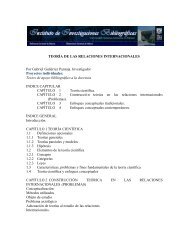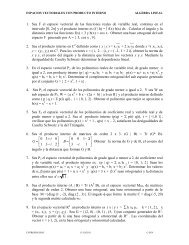Threatened fishes of the world: Poblana alchichica - Páginas ...
Threatened fishes of the world: Poblana alchichica - Páginas ...
Threatened fishes of the world: Poblana alchichica - Páginas ...
Create successful ePaper yourself
Turn your PDF publications into a flip-book with our unique Google optimized e-Paper software.
Environ Biol Fish<br />
DOI 10.1007/s10641-009-9505-4<br />
<strong>Threatened</strong> <strong>fishes</strong> <strong>of</strong> <strong>the</strong> <strong>world</strong>: <strong>Poblana</strong> <strong>alchichica</strong><br />
(de Buen, 1945) (A<strong>the</strong>riniformes: A<strong>the</strong>rinopsidae)<br />
Javier Alcocer & Xavier Chiappa-Carrara &<br />
Elsah Arce & Luis Zambrano<br />
Received: 21 January 2009 /Accepted: 2 June 2009<br />
# Springer Science + Business Media B.V. 2009<br />
Keywords Microendemism . Silverside .<br />
Saline lake . Mexico<br />
Common names: Alchichica silverside (English),<br />
charal de Alchichica (Spanish). Conservation status:<br />
Endangered, NOM-059-ECOL-2001 (SEMARNAT<br />
2002); and critically endangered (CR) (A1ac+2c,<br />
B1+2c, C2b) (IUCN 2008). Identification: D 4–5;<br />
J. Alcocer (*)<br />
Proyecto de Investigación en Limnología Tropical,<br />
FES Iztacala, Universidad Nacional Autónoma de México,<br />
Av. de los Barrios No. 1, Los Reyes Iztacala,<br />
54090 Tlalnepantla, Estado de México, México<br />
e-mail: jalcocer@servidor.unam.mx<br />
X. Chiappa-Carrara<br />
Unidad Multidisciplinaria de Docencia e Investigación<br />
Sisal, Universidad Nacional Autónoma de México,<br />
Puerto de Abrigo S/N, Sisal 97355 Yucatán, México<br />
e-mail: chiappa@servidor.unam.mx<br />
E. Arce<br />
Programa de Posgrado en Ciencias del Mar y Limnología,<br />
Universidad Nacional Autónoma de México,<br />
Ciudad Universitaria, Mexico DF 04510, México<br />
e-mail: elsah07@yahoo.com<br />
L. Zambrano<br />
Departamento de Zoología, Instituto de Biología,<br />
Universidad Nacional Autónoma de México,<br />
Ciudad Universitaria, Mexico DF 04510, México<br />
e-mail: zambrano@ibiologia.unam.mx<br />
A 13–15; P 14–15. Gill rakers on <strong>the</strong> first gill arch,<br />
13–16. Scales 45–56 in a longitudinal series, commonly<br />
>50 (De Buen 1945). Size 50–60 mm (SL),<br />
maximum 11.5 mm (SL). Abundance: Alcocer et al.<br />
(2009) and Arce Uribe (2006) estimated <strong>the</strong> population<br />
abundance between 16, 000 and 21, 000<br />
organisms >1 cm in length. Distribution: Endemic to<br />
Lake Alchichica, Puebla, Mexico (19° 24′ N, 97° 24′<br />
W, 2345 m asl) (Alcocer et al. 2009). Habitat and<br />
ecology: Lentic, saline (8.5±0.2 g·L −1 ) and alkaline<br />
(pH=9.0±0.1) water. Inhabits temperate (15.9±1.5°C),<br />
well oxygenated (>4 mg·L −1 ), clear (euphotic zone 13–<br />
38 m), and oligotrophic water (Adame et al. 2008).<br />
Reproduction: Iteroparous, from February to April,<br />
and July to September, with a spawning peak in<br />
March. The fish spawns entangling eggs with numerous<br />
chorionic filaments that adhere to <strong>the</strong> submersed<br />
macrophytes and on <strong>the</strong> tufa deposits. Feeding: Feeds<br />
mainly on benthic macroinvertebrates (chironomid<br />
larvae and amphipods). Preys vary according to <strong>the</strong><br />
seasonal patterns <strong>of</strong> stratification <strong>of</strong> Lake Alchichica<br />
(Flores Negrete 1998). Threats: The very limited<br />
distribution puts <strong>the</strong> population at risk for rapid or
Environ Biol Fish<br />
sudden extinction due to habitat loss due to groundwater<br />
over-extraction (Alcocer et al. 1998). Conservation<br />
actions: Alchichica is located in <strong>the</strong> Oriental basin<br />
declared Priority Hydrologic Region (Arriaga et al.<br />
2002). However, no fur<strong>the</strong>r specific action has been<br />
taken. Conservation recommendations: Effective habitat<br />
protection; drastic reduction <strong>of</strong> groundwater overextraction;<br />
pollution control. Long-term study <strong>of</strong><br />
population status and biology is required. Remarks:<br />
The conservation status <strong>of</strong> P. <strong>alchichica</strong> was previously<br />
underestimated, should be “in danger <strong>of</strong> extinction” as<br />
indicated by Alcocer et al. (2009) and Arce Uribe (2006).<br />
Acknowledgment The authors thank Hugo Ortíz for <strong>the</strong><br />
drawing <strong>of</strong> P. <strong>alchichica</strong> and CONABIO for financial support.<br />
References<br />
Adame MF, Alcocer J, Escobar E (2008) Size-fractionated<br />
phytoplankton biomass and its implications for <strong>the</strong> dynamics<br />
<strong>of</strong> an oligotrophic tropical lake. Freshw Biol 53:22–31<br />
Alcocer J, Lugo A, Sánchez MR, Chávez M, Escobar E (1998)<br />
Threats to <strong>the</strong> saline lakes <strong>of</strong> <strong>the</strong> Oriental Basin, Mexico,<br />
by human activities. Verh Internat Verein Limnol<br />
26:1383–1386<br />
Alcocer J, Arce E, Zambrano L, Chiappa-Carrara X (2009)<br />
<strong>Poblana</strong> <strong>alchichica</strong>: a threatened silverside species Verh<br />
Internat Verein Limnol 30 (Accepted)<br />
Arce Uribe E (2006) Abundancia y distribución poblacional<br />
de <strong>Poblana</strong> <strong>alchichica</strong> (Pisces: A<strong>the</strong>rinopsidae), charal<br />
endémico del Lago Alchichica, Puebla. Master in Sciences<br />
Thesis. UNAM. México. 58+4 pp<br />
Arriaga L, Aguilar V, Alcocer J (2002) Aguas continentales y<br />
diversidad biológica de México. Comisión Nacional para<br />
el Conocimiento y Uso de la Biodiversidad (ed.). México.<br />
327pp<br />
Flores Negrete E (1998) Estudio poblacional de tres especies<br />
de <strong>Poblana</strong> (Pisces: A<strong>the</strong>rinopsidae) en tres lagos-cráter<br />
de Puebla, México. Master in Sciences Thesis. Facultad de<br />
Ciencias, UNAM. México. 101pp<br />
IUCN (2008) 2008 IUCN Red List <strong>of</strong> <strong>Threatened</strong> Species.<br />
<br />
SEMARNAT (2002) Norma Oficial Mexicana NOM-059-<br />
ECOL-2001, Protección ambiental-Especies nativas de<br />
México de flora y fauna silvestres-Categorías de riesgo y<br />
especificaciones para su inclusión, exclusión o cambio-<br />
Lista de especies en riesgo. Diario Oficial, Miércoles 6 de<br />
Marzo de 2002


